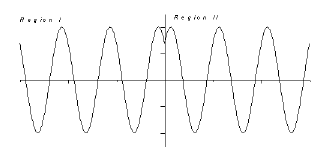Interpreting the wave function as a measure of the probability of finding an electron at a particular location forces a condition on the wave function. At boundaries where the potential energy changes, the wave function must make a smooth connection between its segments in the two regions. If the segments did not meet at the boundary, then each would give a different probability of detecting the electron there. Since both values of the wave function represent the electron at the same location, two different values for the probability at the same point would be meaningless.

Wave functions with kinds are also not acceptable.